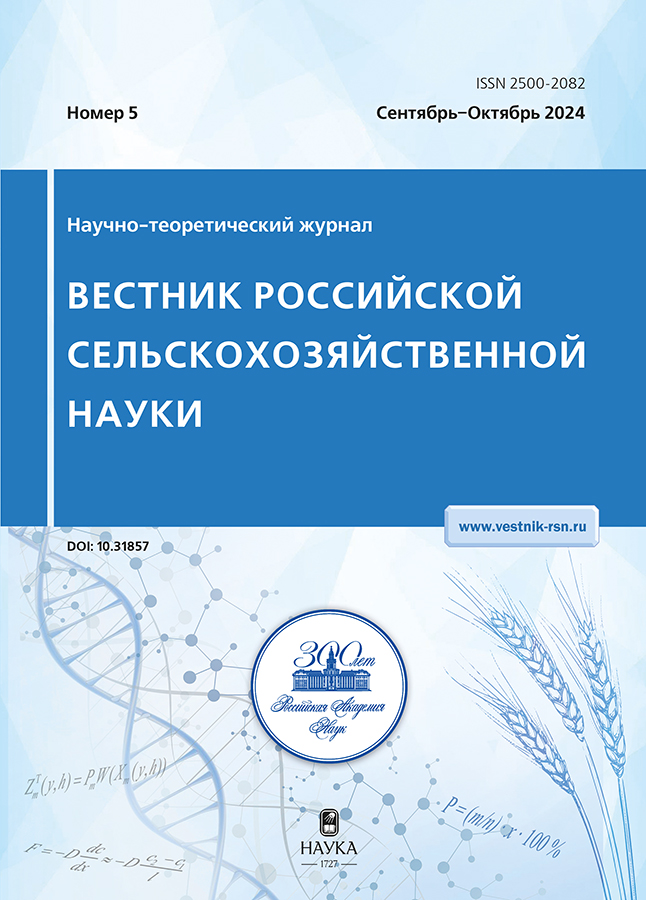Primary screening of growth-stimulating properties of rhizosphere microorganisms in relation to tomato seeds
- 作者: Galperina A.R.1, Soprunova O.B.1, Parkhomenko A.N.1
-
隶属关系:
- Astrakhan State Technical University
- 期: 编号 5 (2024)
- 页面: 37-41
- 栏目: Crop Production and Selection
- URL: https://vietnamjournal.ru/2500-2082/article/view/659244
- DOI: https://doi.org/10.31857/S2500208224050083
- EDN: https://elibrary.ru/ztfkfl
- ID: 659244
如何引用文章
详细
The ability of bacterial isolates isolated from the rhizosphere of cultivated and wild plants of arid ecosystems of the Astrakhan region, which have the ability to tryptophan-induced synthesis of indolyl-3-acetic acid, to stimulate the germination of tomato seeds of the varieties “Sanka”, “Volgogradsky”, “Cosmonaut Volkov”, was studied. “Newbie” Experimental studies were carried out through laboratory experiments by incubating seeds in humid chambers; laboratory germination and morphometric parameters of seedlings were assessed. It was revealed that most of the studied suspensions of isolates have a stimulating effect on tomato seeds. High germination (90% or more) of seeds of the “Sanka” variety was observed when 12 isolates were treated with suspensions; variety “Volgogradsky” – suspensions of 9 isolates; variety “Cosmonaut Volkov” – suspensions of 2 isolates; variety “Novichok” – suspensions of 3 isolates. Suspensions of isolates 16/19 and 31/20 contributed to high germination of seeds of all varieties: up to 86.6–100% and 90–100%, respectively, and isolate 9/19 significantly reduced the germination of seeds of the varieties “Volgogradsky”, “Cosmonaut Volkov” and “Novichok” by 66.6–56.7%. When assessing the morphometric parameters of seedlings in the experiment, it was noted that the suspension of isolate 16/19 helps to increase the biomass of the varieties “Sanka”, “Volgogradsky” and “Cosmonaut Volkov” up to 273–449%. Suspension of isolate 31/20 has a stimulating effect on the morphometric parameters of seedlings of all varieties: it stimulates root development by 73.3–183.3%, stem development by 46.8–100.5%. The isolate 9/19 suspension not only inhibits seed germination, but also causes a reduced accumulation of seedling biomass, inhibits the development of roots and stems of seedlings of the varieties “Volgogradsky”, “Cosmonaut Volkov” and “Novichok”. Thus, during experimental studies, isolates (16/19 and 31/20) of rhizosphere bacteria were identified that have a stimulating effect on both the germination of tomato seeds and the morphometric parameters of seedlings.
全文:
作者简介
A. Galperina
Astrakhan State Technical University
编辑信件的主要联系方式.
Email: alina_r_s@rambler.ru
PhD in Biological Sciences, Associate Professor
俄罗斯联邦, AstrakhanO. Soprunova
Astrakhan State Technical University
Email: alina_r_s@rambler.ru
Grand PhD in Biological Sciences, Professor
俄罗斯联邦, AstrakhanA. Parkhomenko
Astrakhan State Technical University
Email: alina_r_s@rambler.ru
PhD in Biological Sciences, Associate Professor
俄罗斯联邦, Astrakhan参考
- Ahmedova P.M. Ocenka novyh gibridov tomata v zashchishchennom grunte // Vestnik rossijskoj sel’skohozyajstvennoj nauki. 2021. №1. S. 37-41. https://doi.org/10.30850/vrsn/2021/1/37-41
- GOST 12038-84. Semena sel’skohozyajstvennyh kul’tur. Metody opredeleniya vskhozhesti = Agriculturalseeds. Methods for determination of germination: izdanie oficial’noe: utverzhden i vveden v dejstvie Postanovleniem Gosudarstvennogo komiteta SSSR po standartam ot 19.12.84 № 4710: data vvedeniya 1986-07-01. M.: Standartinform, 2011.
- Cerkovnyak L.S. Fosfatmobiliziruyushchie bakterii Bacillus subtilis – producenty soedinenij fenol’noj prirody // Prikladnaya biohimiya i mikrobiologiya. 2009. T .45. S. 311–317.
- Yusupova D.M., Bareeva A.Sh., Gal’perina A.R., Soprunova O.B. Izuchenie sposobnosti rizosfernyh mikroorganizmov k produkcii IUK i vliyaniyu na rost rastenij // Innovacii i prodovol’stvennaya bezopasnost’. 2023. № 3. S. 83–90. https://doi.org/10.31677/2311-0651-2023-41-3-83-90
- Almaghabi O.A., Massoud S.I., Abdelmoneim T.S. Influence of inoculation with plant growth promoting rhizobacteria (PGPR) on tomato plant growth and nematode reproduction under greenhouse conditions // Saudi Journal of Biological Sciences. 2013. V. 20. № 1. P. 57–61. https://doi.org/10.1016/j.sjbs.2012.10.004
- Dutta, S., Podile, A.R., Plant growth promoting rhizobacteria (PGPR): the bugs to debug the root zone // Critical Reviews in Microbiology. 2010. Vol. 36. № 3. Р. 232–244. https://doi.org/10.3109/10408411003766806
- Gupta, G., Parihar, S.S., Ahiwar, N.K. et al. Plant growth promoting Rhizobacteria (PGPR): Current and Future Prospects for Development of Sustainable Agriculture // Journal of Microbial Biochemical Technology. 2015. Vol. 7. № 2. P. 96–102. https://doi.org/10.4172/1948-5948.1000188
- Hayat R., Ahmed I., Sheirdil R.A. An overview of plant growth promoting rhizobacteria (PGPR) for sustainable agriculture. In: M. Ashraf, M. Oztürk, M.S.A. Ahmad, and A. Aksoy (eds.) Crop production for agricultural improvement. Berlin: Springer, 2012. P. 557–579. https://doi.org/ 10.1016/B978-0-443-16030-1.00017-1.
- Moustaine M., Elkahkahi R., Bebbouazza A. et al. Effect of plant growth promoting rhizobacterial (PGPR) inoculation on growth in tomato (Solanum lycopersicum L.) and characterization for direct PGP abilities in Morocco. International Journal of Environment, Agriculture and Biotechnology. 2017. Vol. 2. № 2. P. 590–596. https://doi.org/10.22161/ijeab/2.2.5
- Perez-Rodriguez M.M., Mariela P., Victor L. Et al. Pseudomonas fluorescens and Azospirillum brasilense increase the yield and fruit quality of tomatoes under field conditions // Journal of Soil Science and Plant Nutrition. 2020. V. 20. № 4. P. 1614–1624. https://doi.org/10.1007/s42729-020-00233-x
- Ramavath K., Hameeda B., Reddy G. Enhancement of Plant Growth in Tomato by Inoculation with Plant Growth Promoting Bacillus spp // World Journal of Agricultural Research. 2019. Vol. 7. № 2. P. 69–75. https://doi.org/10.12691/wjar-7-2-5
- Teale W.D., Paponov I.A., Palme K. Auxin in action: signalling, transport and the control of plant growth and development // Natures reviews. Molecular cell Biology. 2006. V. 7. № 11. P. 847–859. https://doi.org/10.1038/nrm2020
补充文件











